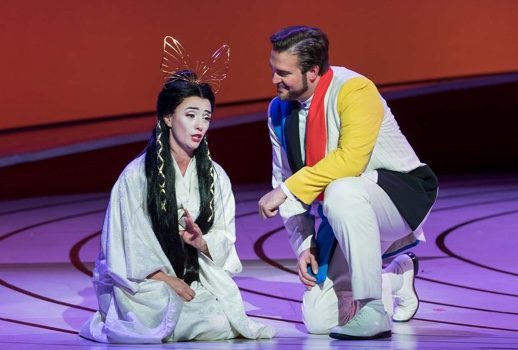
So I was pleasantly surprised to find that I am in fact not indifferent to the plight of abandoned teenage brides; I just needed the right singer to help reinvigorate the work. That singer is the Albanian soprano Ermonela Jaho, fresh from a well-received run of Butterflies at Covent Garden and presenting the role in the D.C. before she lands at the Met next year.
Jaho offers a distinctive characterization, bringing an endearing neurotic energy to Butterfly’s extravagant faith in Pinkerton and a better life. She makes Butterfly’s optimism feel almost like a tragic flaw, rather than simply a byproduct of her innocence, and the ensuing unraveling is all the more poignant for the specificity she finds.
This interpretation comes alive through a compelling vocal performance that lives as much in the quiet moments as the role’s iconic emotional climaxes. The first Act is a slow burn, Jaho using a variety of vocal shadings to bring to life Butterfly’s description of her past and calm confidence in her future with Pinkerton. Her journey in the duet is especially gripping, with the ecstatic conclusion as much about Butterfly feeling vindicated in her choice of Pinkerton as it is about her submission to passion.
Acts II and III were filled with riveting moments and unexpected choices. Her “Un bel di” was anxious and devastating, its high point not the big tune but a heartbreaking, audible gasp before the words “Chi sarà? Chi sarà?” Her relief at the news of Pinkerton’s arrival was deeply felt and provided a true moment of catharsis after the tension of Act II, while her subsequent discovery of Pinkerton’s betrayal eschewed big statements in favor of quiet, inward facing anguish, conveyed through some beautifully spun dynamic effects.
Her commitment in the death scene was absolute and chilling, though Jaho’s more modest, focused sound falls a bit short of the lavish, overwhelming sound others can bring to this moment. The drama continued after the stage went dark, as she reappeared, utterly drained, to take an immediate bow, sinking to the stage and using the edge of the curtain for support.
Jaho’s cool, urgent soprano is an effective vehicle for her portrayal, maintaining interest with a variety of colors throughout her middle register and opening into a cutting top characterized by a quick vibrato. Though capable of stunning precision in softer moments, at times she can sacrifice beauty for reckless abandon in the climaxes. It’s not a particularly loud voice, and fullness of tone gets lost as she works hard to cut through the orchestra. While some passages were on the quiet side this worked out fine for the Kennedy Center; the Met may be a different story.
Brian Jagde makes his WNO debut in this run as well, though the DMV is familiar with his Pinkerton from a Virginia Opera production several years back (memorable/infamous for adding a “grown-up Trouble” character that observes the action). Jagde’s lieutenant is a well-known quantity by now, and for good reason—the consistent warmth and imposing size of his voice is simply thrilling in this music.
Stylistically this is a decidedly American Pinkerton: he employs a shock and awe strategy with Cio-Cio San, turning out big waves seductive sound, in contrast to, say, the more refined legato of Italianate Pinkertons merely moonlighting in the U.S. Navy. But he is certainly no less persuasive. (On a related note, it appears that 2017 has at least one good thing going for it: no one tried to do that tacky curtain call booing of Pinkerton.)
Elsewhere in the cast, mezzo Kristen Choi offered a sympathetic characterization and compelling sound for Suzuki, including an especially fine contribution to the flower duet with Jaho, here exquisitely delicate and well-balanced. Troy Cook’s even baritone provided an attractive sound for Sharpless, though he was overwhelmed by the pit at times.
Timothy Bruno, a WNO young artist who seems to find himself in just about every other mainstage production, lent his commanding bass to The Bonze and ably carried off more complicated stage business than is usually required of Bonzes.
Another young artist, mezzo Allegra de Vita, portrayed an enjoyably unpleasant Kate Pinkerton, who could clearly care less about Cio-Cio San’s plight despite a few required niceties. Turns out Butterfly Act III works just fine without a detour to feel sorry for the white lady.
WNO Music Director Phillipe Auguin is back on the podium for the first time since his Ring appearances last spring. Indeed, Auguin’s careful gradations of tempi to highlight different motifs in Puccini’s score reminded one of his Wagner, as did his vital, bravura reading of the Act III prelude, and a cataclysmic finale. The orchestra tripped over some of this aggressive tempi in a few places, like the opening bars, but overall delivered a warm, sensitive performance.
The designer for this 2006 coproduction with San Francisco and Opera Omaha is the artist Jun Kaneko, whose playful use of bold primary colors, simple shapes, and abstract video projections were the backdrop for WNO’s fanciful 2014 production of The Magic Flute. Using the same basic materials, Kaneko frames a surprisingly watchable minimalist production which keeps the focus squarely on Leslie Swackhamer’s straightforward direction.
The simple unit set consists of a ramp and one raised platform, with singers occasionally going behind a single screen representing Butterfly’s house. In naturalistic colors this might look too bleak, but Kuneko’s riotous color palette infuses the stage with life and interest while rarely distracting from the interactions between the characters.
If there’s a major misstep, it is the staging of Butterfly’s death. Her final scene is performed in front of a projection screen which displays a large red dot on a white background, which then starts to “bleed” after she stabs herself, an odd reference to the actual flag of Japan and heavy handed depiction of the death that feels out of step with the rest of the show.





Comments